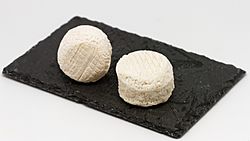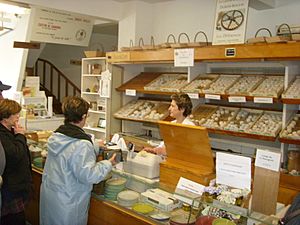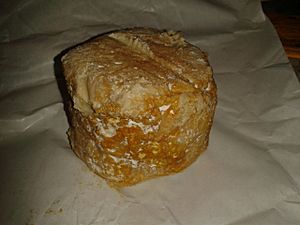Crottin de Chavignol facts for kids
Quick facts for kids Crottin de Chavignol |
|
|---|---|
 |
|
| Country of origin | France |
| Region, town | Loire, Chavignol |
| Source of milk | Goat |
| Pasteurised | No |
| Texture | Soft-ripened, crumbly |
| Aging time | At least 4 weeks |
| Certification | French AOC 1976 |
| Named after | Lua error in Module:Wikidata at line 70: attempt to index field 'wikibase' (a nil value). |
Crottin de Chavignol is a special type of goat cheese made in the Loire Valley region of France. This delicious cheese is very famous and is the pride of a small French village called Chavignol, France, which has only about 200 people living there.
Contents
The Story of Crottin de Chavignol
This unique goat cheese has a long history! People have been making this small, round cheese in the Chavignol area since the 1500s. The first time it was officially written down was in 1829. A tax inspector noted its name and some details about it.
The name "Crottin" has a couple of interesting ideas behind it. One idea is that the word crot meant a small oil lamp made from clay. This lamp looked a lot like the mold used to shape the cheese. Another idea is that older Crottin cheese gets harder and darker. It can start to look like animal droppings, which in French is called crotte.
Keeping Crottin de Chavignol Special
Crottin de Chavignol is protected by a special French seal called AOC. This means it has to be made in a traditional way. If a cheese is called "Crottin de Chavignol," it must come from the area around Chavignol. It also has to follow strict rules about how it's made. This helps make sure every Crottin de Chavignol cheese is of high quality.
Taste and How It Ages
When Crottin de Chavignol is young, it tastes mild and a bit nutty. At this stage, called Chavignol jeune, the cheese inside is firm. Its outer skin, or rind, is white.
As the cheese gets older, it ripens and changes. This stage is called Chavignol bleuté. The flavor becomes stronger, and the rind gets harder. When the cheese is fully mature, known as Chavignol affiné, the inside becomes crumbly. The mold on the rind turns a bluish color. People enjoy eating this cheese at all three stages of its aging process.
Ways to Enjoy Crottin de Chavignol
A very popular way to eat Crottin de Chavignol is baked on top of a fresh green salad. This dish is often served with a Sancerre wine. Sancerre wine also comes from the same region where the cheese is made. While it's often served warm as a first course, Crottin de Chavignol is also great cold. You can find it as part of a selection of cheeses on a cheese board.
See also
 In Spanish: Crottin de Chavignol para niños
In Spanish: Crottin de Chavignol para niños



